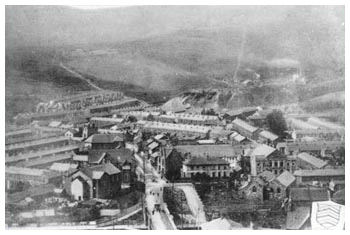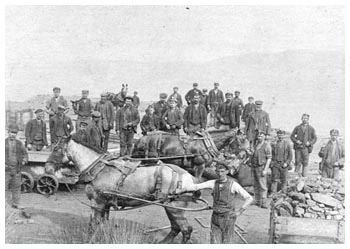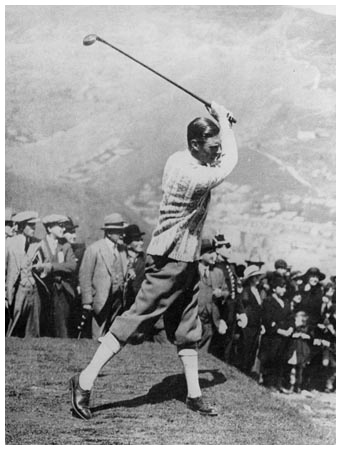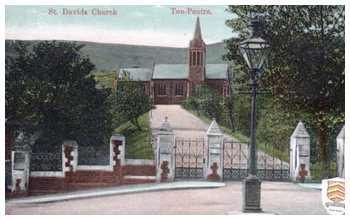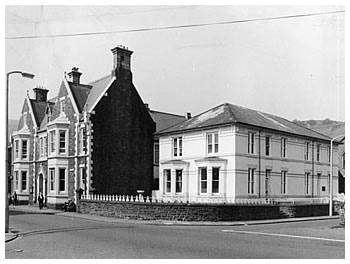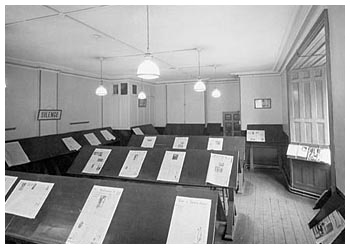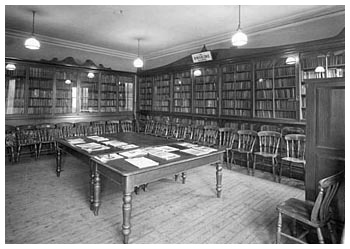
Ton Pentre |
|
Ton Pentre, in common with a number of the villages of the Rhondda, derives its name from a farm, which stood on the land pre-industrialisation. The farm, and a few cottages clustered around it were known as ‘Y Ton', Ton being the welsh word for meadow. The village that grew up was originally referred to as Ton, but later became known as Ton Pentre to distinguish it from Tonypandy. Indeed in the 1906 ‘Kelly's Directory of South Wales' the town is referred to as Ton or Ton Pentre or Ton Ystrad. The 1847 tithe map of the area shows the land as being owned by the Crawshay Bailey estate and farmed by tenants such as Evan Jenkins and Mary Bailey, at Ton farm and Tyr Yr Eglwys respectively. |
|
Tyr Yr Eglwys being named for the only other building of note in the area at that time, the parish church of St. John's (Eglwys being the Welsh word for church). Records show that a place of Christian worship existed on this site from as early as possibly the sixth or seventh century. Ton also boasted another large church, that of St. David a chapel of ease to St. Johns. This was erected in 1881 by Crawshay Bailey at a cost of £6,000, and had room for 550 worshippers. Another notable building in Ton Pentre was the ‘Ocean Collieries, Maindy and Eastern Workmen's library' in Church Road. This was erected by the workmen of the Maindy and Eastern pits and opened in 1895 at a cost of £4,000. |
General view of Ton Pentre Circa 1900 |
Ton Pentre miners Circa 1890 |
Ton Pentre, for a time, also boasted its very own golf course where a future King of England was to play a round in 1924. An impression of how busy each of the little ‘townships' of The Rhondda were in the latter half of the 19th and early part of the 20th century can be seen from the listings for Ton Pentre in the 1901 Kelly's Directory. The commercial listing for Ton Pentre included, amongst others, 8 butchers, 2 dress makers, 3 hair dressers, 9 grocers, 3 greengrocers, 10 shopkeepers, 6 tailors, 4 boot makers, 4 public houses, a cab proprietor, a blacksmith, 3 builders and contractors, a carter, a farmer, a news agent, 2 iron and brass founders, a chemist and druggist as well as the Ton Industrial Co-Operative Society. |
| In contrast to today, with the easy availability of public transportation and mass car ownership leading to the age of the supermarket and out own town shopping, each small town was forced to provide all the necessities of daily life leading to thriving town centres. The pioneer of coal working in this area of the Rhondda, and hence the development of Ton itself, was David Davies, Llandinam. Who together with his partners negotiated the lease of 8,000 acres at Cwmparc and Maendy at Ton Pentre in the late 1860's? The rich steam coal seams were eventually reached at depths of over 200 yards at the Maendy colliery. Unlike some mine owners who made little or no effort in terms of providing housing for the influx of workers to their pits, David Davies was praised for the miners' cottages he constructed for his workers at Ton Pentre. |
|
Ton Pentre Golf Club |
|
In the early 1920's on a piece of mountain above Ton Pentre, known as ‘Waun Ton Pentre' where children had for years played football, a small band of local miners began to set up a very basic golf course. They had managed to collect a few second hand golf clubs, and were given a few acres of mountainside on which to play. For the first year the course consisted of four holes cut with ex-service jack knives in each corner of the pitch, with no greens or tees. At this time the Ocean Area Recreation Union was formed, and succeeded in negotiating with the Ocean Coal Company and the Crawshay Bailey Estate, extending the course to some fifty acres and securing for the members a direct lease on the land. The club held its first annual meeting in the drawing room of a local minister, and local miners volunteered their time to set up this new expanded course, which included setting mountain fires to clear the rough grass on the new course. Grants from the Miners Welfare fund, and members' subscriptions, allowed for the hiring of a dedicated groundsman , which in time led to improved greens and tees for this nine hole course. The club thrived, membership rose and an old barn was converted to a pavilion for players. Then in May 1924 came the club's proudest moment, when His Royal Highness the Duke of York, later King George VI, agreed to play a foursome match there against Mr. Frank Hodges M.P. On the 17th May huge crowds turned out to see the future King, play a round of golf on what had until recently been a bare patch of mountainside, The Duke eventually losing the match. Although the club thrived for a number of years by 1960 local historian Arthur Hazzard describes the course as having been abandoned for several years, and as having reverted to farming use. |
His Majesty King George VI, when Duke of York, playing golf at Ton Pentre, May 17th, 1924 |
| The Story of the Parish of St. David, Ton Pentre | |
St Davids Church |
For a history of the Parish and church of St. David's we are fortunate to have a book outlining the events written by a Muriel Evans in 1959. She deals in detail with the incumbency of the Rev. William Lewis at whose instigation St. David's and St. Mark's were built. The Reverend Lewis first came to the Rhondda in 1869 at the age of 33 and remained until his death in 1922. When he first came to take charge of the parish of Ystradyfodwg the task before him was a difficult one. At that time the parish extended from Rhigos in the North, to Ffrwd Amos brook in Dinas in the South West to the meeting of the two Rhondda Rivers at Porth in the South East. It also included all the lands on the right bank of the Rhondda Fach River as well as the small valleys of Cwmparc and Clydach and reached as far as Gilfach Goch in the West. |
| For the rapidly expanding population of this parish there were only four clergymen, two Mission Rooms and two churches. The two churches being the old parish church of St. John the Baptist in Ton Pentre and the Church of St. Mary the Virgin in Treherbert, built by the Bute family in 1868. The Mission rooms were the schoolroom at Treorchy, which later became St. Mathew's church, and the schoolroom at Pentre. Thus the Rev. Lewis set to work endeavouring to build churches wherever the increasing population settled. The first church he built was an iron building in Ferndale, at a cost of £620 in 1874, followed by a Mission Room of St. Stephen's Ystrad in 1876, and in 1878 the Church of St.Andrew, Llwynypia. He then turned his attention to Ton Pentre and Gelli where the population was expanding due mainly to the opportunities for work provided by the Maindy and Bwllfa collieries. The old parish church at Ton Pentre was small and somewhat dilapidated and prone to flooding from the nearby stream, and thus a new church was deemed necessary. |
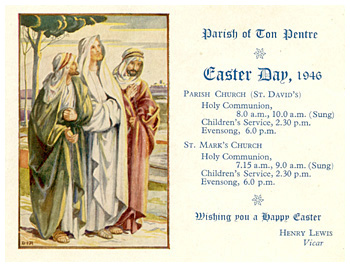 |
| The Reverend Lewis discussed his needs with Mr. Crawshay Bailey the major landowner of the area, and whose support for church building was well documented. Mr. Bailey agreed to build a new church for the inhabitants of Ton Pentre and District and also agreed to give the site for the building and also one for a vicarage, a total of some three and a half acres. By April 1879 a site above the village had been chosen and approved and an architect, Mr. I.B. Fowler of Brecon chosen to draw up the plans. Messrs. Shepherd of Cardiff were contacted to construct the new church with an initial contract price of £4,000, but with the extras such as cost of the land, fences etc. the true price would be nearer £6,000 or £7,000. Mr. Crawshay Bailey laid the foundation stone for the church on Thursday June 17th 1880, though by that time construction was already well under way. Mr. Bailey hired a special train to bring him and his family and friends to Ystrad station for the ceremony, and ‘ all the people of the district turned out to welcome him'. His route from the station to the church site was lined with flags, streamers, and arches of evergreens and flowers. At one o'clock that afternoon a procession set out for the church from Crawshay Bailey's offices in Ton Pentre. It consisted of a 200 strong choir, followed by a large number of clergy including the Bishop of Llandaff, Mr and Mrs. Crawshay Bailey as well as numerous other family members and guests, which included many of the ‘gentry' of Monmouthshire and Glamorgan. An estimated 3,000 people witnessed the ceremony itself, and saw Mr Crawshay Bailey present to the Archdeacon the deeds of title to the lands and building. Following this Mrs. Bailey laid the memorial stone, in a cavity under which were placed a large bottle containing newspapers of the day and a number of ‘coins of the realm'. The church was opened on October 27th 1881; a license for the use of the building for Divine worship having been obtained, but the church was not consecrated at this time. Holy Communion was celebrated at 8 am, morning service at 12 noon, the preacher being the Archdeacon of Llandaff, and an evening service at 7pm, the preacher being the Vicar of Llandaff. In 1902 Crawshay Bailey's daughters installed a brass tablet in the church commemorating his generosity to the church. The church itself suffered many problems, indeed within a few weeks of it's opening gales blew off two of the crosses placed on the gables, and by 1900 the building had become seriously dilapidated with a contemporary report stating; ‘The building throughout requires repair; the roof is not watertight and consequently the walls are in a very bad state indeed, while the windows, the floor and the aisles of the building are also much worn. In addition to this the lighting and heating arrangements sadly require renovating. The tower also requires immediate attention.' Repairs were undertaken at a cost of nearly £600 and the church was reopened in March 1901. As from March 26th 1920 St. David's Ton Pentre became a separate parish. The church was demolished in the 1980's and replaced by sheltered accommodation flats for the elderly named Ty Ddewi. |
|
| Ton Pentre Workmen's Hall and Institute | |
| The Institute in Church Road, adjacent to the Crawshay Bailey Estate Office was officially opened in September 1895. Prior to its opening a meeting was held at which Mr. William Jenkins J.P. performed the official opening and a number of speeches and songs were given. Many of the speeches applauded the workmen's desire to educate themselves in their spare time as opposed to spending their time in the public houses of the area. | |
Ton Pentre Workmen's Hall and Institute |
The Rhondda Chronicle newspaper report of the opening of the 'Maindy and Eastern Workmen's Institute', (as it was then known after two of the local collieries whose workmen paid for the Institute), gives us an insight into the formation of such an institution in the nineteenth century. It describes how prior to the passing of the Education Act workmen of the District paid for the education of their children through a system of ‘poundage' whereby a penny was deducted from every pound they earned. With the introduction of free education a meeting was held by the workmen of Maindy and Eastern collieries, whereupon they decided to continue with the poundage system in order to fund the building of a workmen's institute. According to the report a site containing two shops and a number of cottages was purchased for £1,200 and the buildings demolished to make way for the institute, plans were drawn up by Abel Richards and the building erected by Alban Richards. The original hall consisted of a ground floor with a news room, refreshment room and caretakers room and a first floor library and committee room whilst in the attic were two bedrooms and storerooms. |
With the success of the Institute it was decided to expand the original premises and thus in 1904 a workmen's hall attached to the Institute was opened. Mrs. Jenkins of Ystradfechan performed the opening ceremony and the key to the hall was presented to her by the daughter of the architect Jacob Rees. By 1908 the trustees had begun to rent the hall out to a private company for the showing of ‘animated pictures ‘or early silent movies. Very quickly the committee and trustees of the hall realised the profits that could be made from this enterprise and saw it as ‘their duty that Institute members reaped the rewards'. As such they started to show moving pictures themselves, using the profits gained to set up a relief fund to 'alleviate the distress of sick and disabled workmen'. |
The Reading Rooms |
The Library |
The cinema was converted in 1931 with the installation of a ‘talkie' machine enabling it to show talking pictures, developments such as ‘Cinemascope' and stereophonic sound were also pioneered in the Rhondda at the Hall. The Institute and Hall suffered in the 1940's with the closure of the local mines and the subsequent dwindling of revenue from miners' contributions. Changing it's name to the Ton Pentre Workmen's Hall and Institute it continued to show films until 1971 whereupon it changed its usage to a bingo hall. This itself closed in 1989, leaving the Hall derelict until in 1991 when it was reopened as a cinema under the new name of ‘The Phoenix'. |
